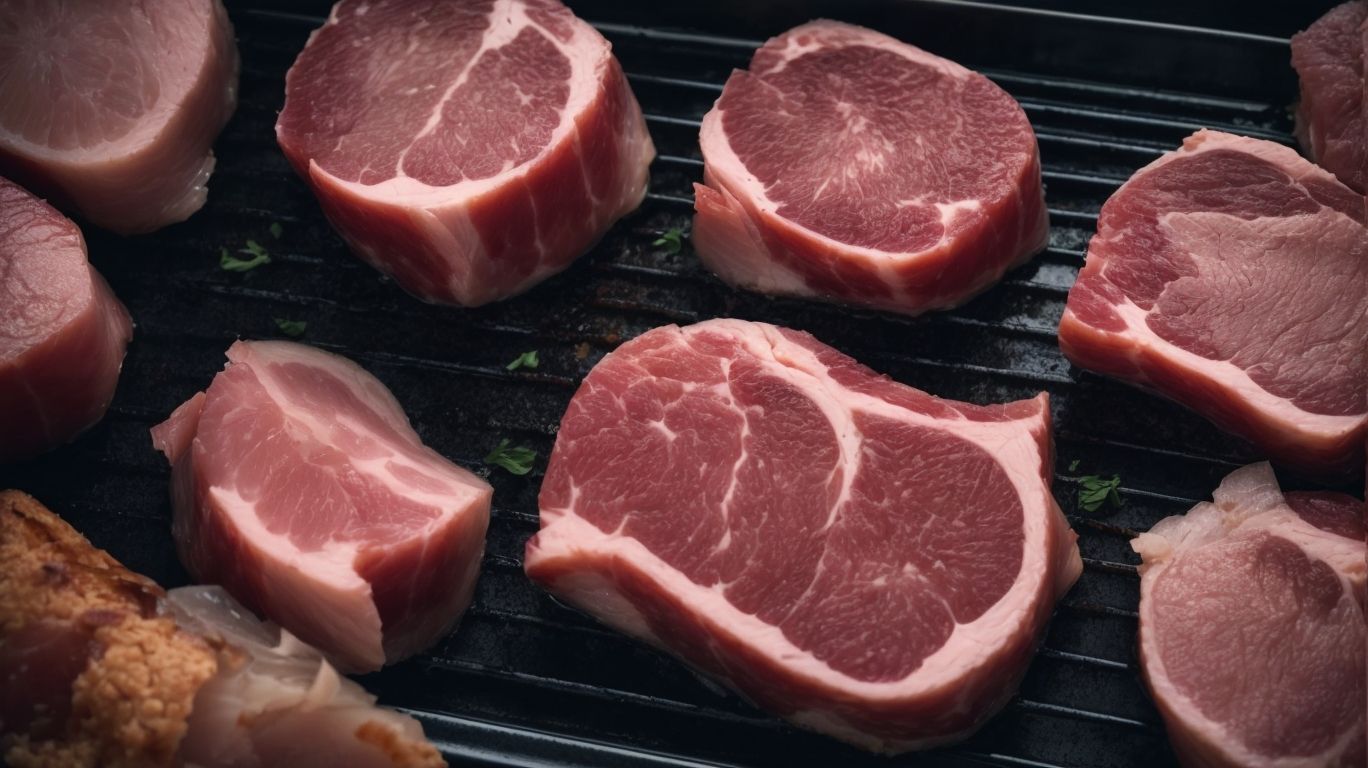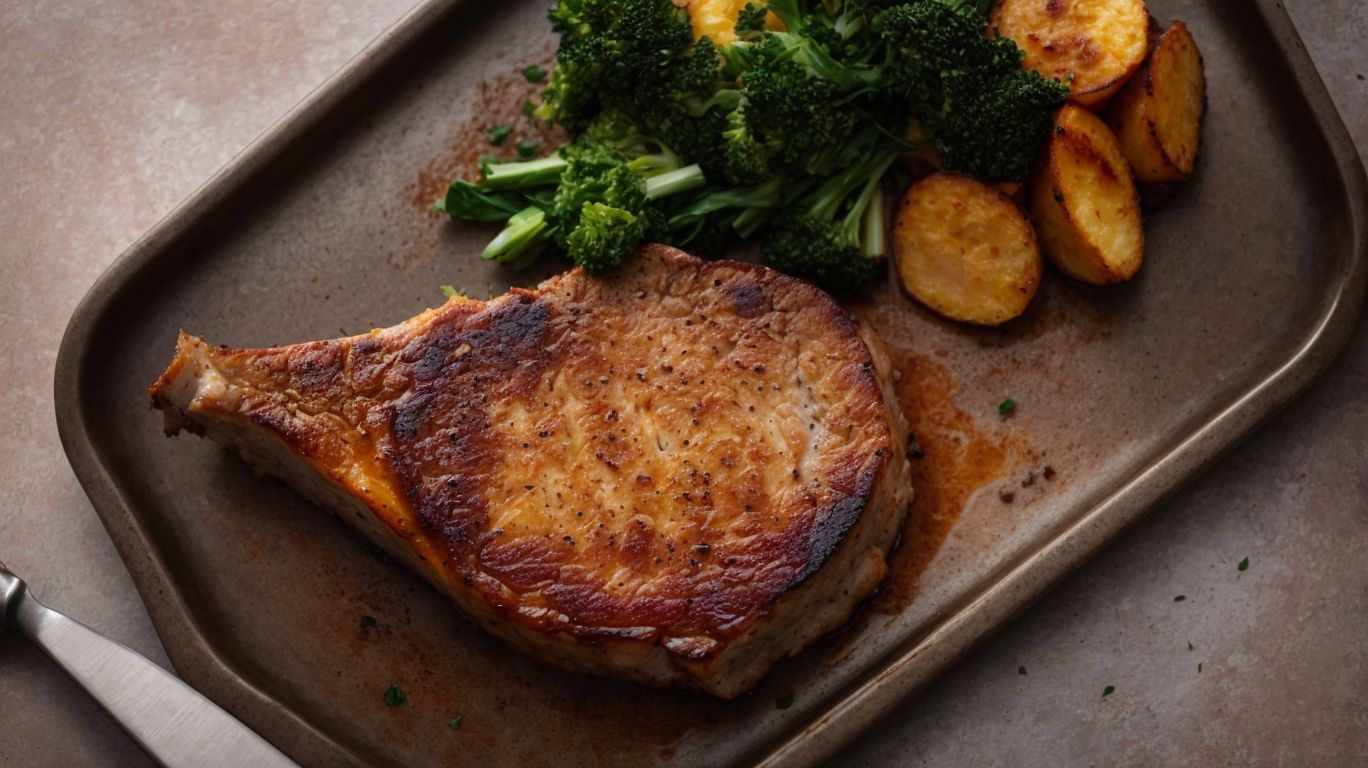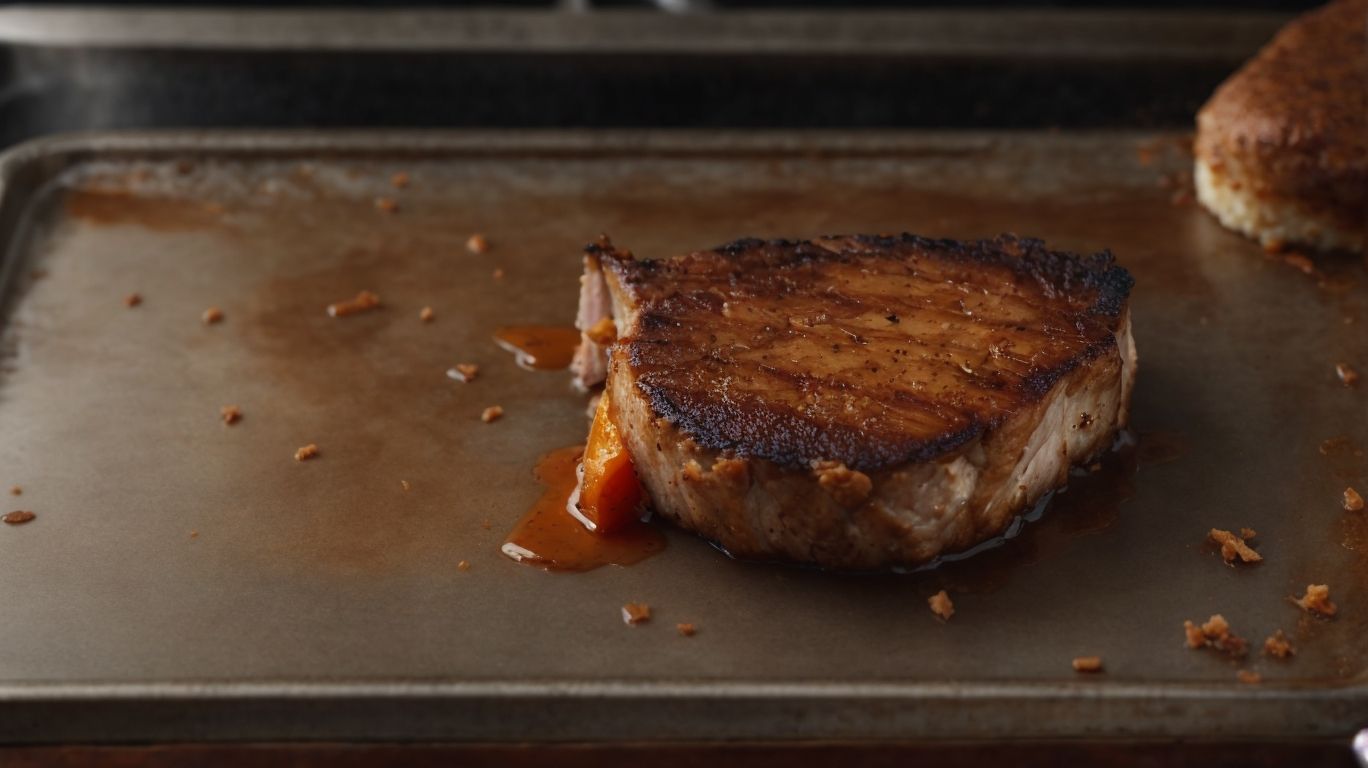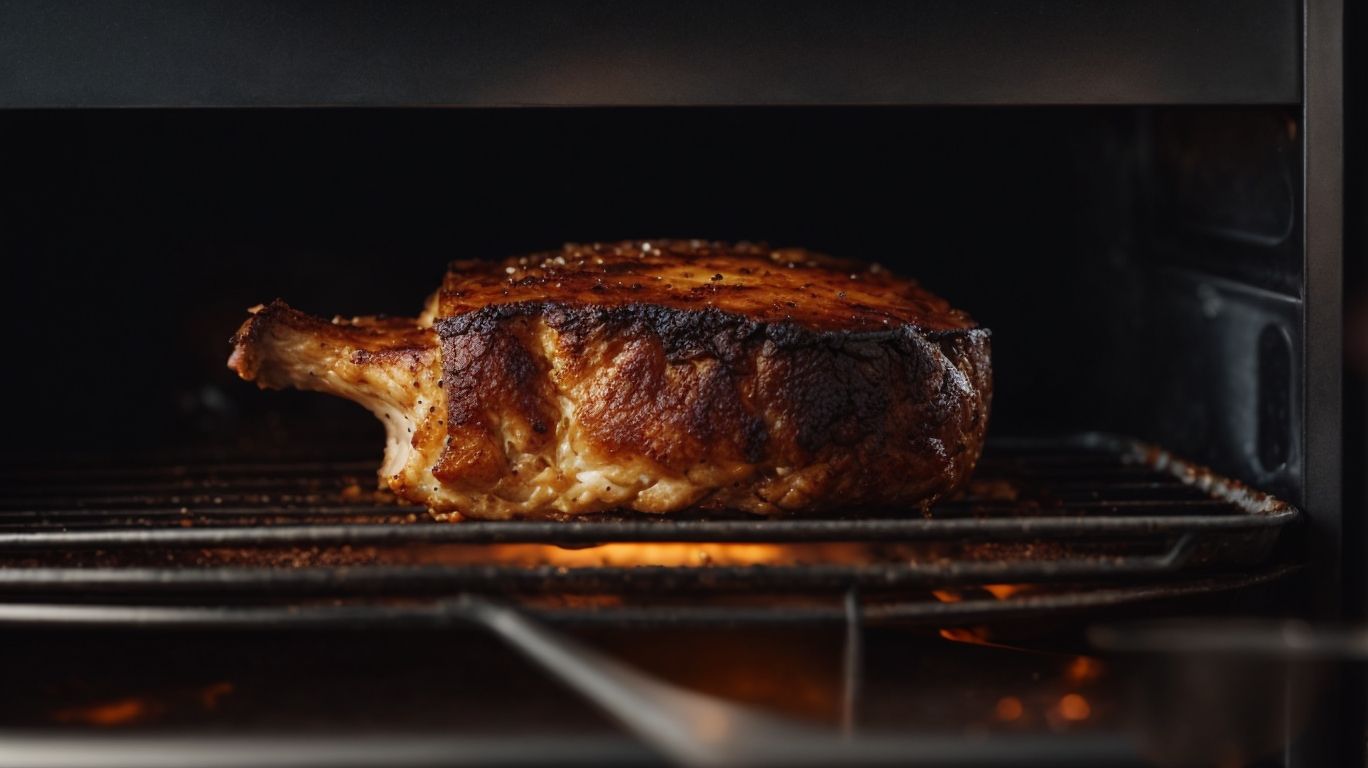How to Bake Pork Chops in the Oven?
Are you looking to elevate your pork chop game?
In this article, we will discuss the key ingredients needed for baking pork chops in the oven, as well as the preparation and cooking process.
From selecting the perfect seasoning to ensuring your pork chops are cooked to perfection, we will cover all the tips and tricks you need to know.
So, grab your apron and let’s get cooking!
Key Takeaways:
What Are the Ingredients Needed for Baking Pork Chops in the Oven?
To bake delicious pork chops in the oven, you will need high-quality pork chops seasoned with a flavorful blend of spices and a touch of olive oil.
Choosing the right cuts of pork chops is essential for a successful dinner. Opt for boneless pork chops that cook evenly and absorb the flavors effortlessly. A well-balanced rub comprising salt, pepper, garlic powder, and paprika will elevate the taste profile of the dish. Drizzle a moderate amount of olive oil over the seasoned pork chops to enhance moisture retention and add a Mediterranean-inspired flavor note. Remember to preheat your oven to the recommended temperature before placing the chops on a baking tray for an even bake.
Pork Chops
Pork chops are the star of this dish, available in both boneless and bone-in options to suit individual preferences.
When opting for boneless pork chops, you’ll find they cook faster and are leaner, making them a great choice for those seeking a quicker meal.
On the other hand, bone-in pork chops offer a richer flavor and juicier texture due to the presence of the bone. The bone acts as a natural insulator, helping to keep the meat moist and flavorful throughout the cooking process.
Seasoning
The seasoning for the pork chops includes a savory blend of garlic powder, onion powder, oregano, and other aromatic spices to elevate the flavor profile.
Each of these spices plays a crucial role in enhancing the overall taste of the pork chops.
- Garlic powder adds a distinct earthy flavor and a subtle kick of pungency.
- Onion powder brings a sweet and savory depth to the seasoning.
- The inclusion of oregano offers a herbaceous and slightly bitter note that complements the richness of the pork meat.
When creating a well-balanced seasoning mix, it is essential to consider the harmonious combination of flavors and aromas.
- Garlic powder,
- Onion powder, and
- Oregano work synergistically to create a complex and flavorful rub that enhances the natural taste of the pork chops.
Oil or Butter
Olive oil is the preferred choice for coating the pork chops before baking, adding a hint of richness and ensuring a moist and tender result.
When using olive oil in baking, it not only acts as a fantastic natural tenderizer for the pork chops but also helps to lock in moisture and flavor throughout the cooking process.
Olive oil contains healthy monounsaturated fats that contribute to a juicier texture and provide a delightful taste to the dish.
Applying a generous drizzle of olive oil over the seasoned pork chops before placing them in the oven can elevate the final dish’s overall succulence and richness.
Optional Ingredients
For those looking to add some extra flair to their pork chops, consider incorporating additional ingredients like herbs, citrus zest, or a homemade sauce for a personalized touch.
Herbs like rosemary and thyme can bring a fragrant earthiness, while a hint of citrus zest from lemon or orange adds a zesty brightness to the dish. You could also experiment with a rich balsamic glaze or a tangy mustard-based sauce to enhance the savory flavors of the pork chops. Don’t be afraid to get creative and mix and match these ingredients to find your perfect flavor combination.
How to Prepare the Pork Chops for Baking?
Before baking, it is crucial to prepare the pork chops by following a simple yet effective seasoning method using paprika, garlic powder, onion powder, and oregano.
Start by patting the pork chops dry with a paper towel to ensure the seasonings adhere well to the meat. In a small bowl, mix together the paprika, garlic powder, onion powder, and oregano in the desired proportions, depending on your taste preferences.
Gently rub the seasoning mixture onto both sides of the pork chops, ensuring an even coating. For optimal flavor infusion, allow the seasoned chops to marinate in the refrigerator for at least 30 minutes, but ideally for 2-4 hours.
This marination process allows the flavors to penetrate the meat, resulting in juicier and more flavorful pork chops once baked.
Thawing the Pork Chops
Thaw the pork chops thoroughly in the refrigerator to ensure uniform cooking, paying attention to their thickness and the recommended temperature for safe thawing.
Properly thawing pork chops is crucial for maintaining their flavor and texture, as well as for food safety. Refrigeration slows down bacterial growth, reducing the risk of contamination. When thawing, the thickness of the pork chops plays a significant role in determining the required time for complete thawing. Thicker cuts will take longer to thaw compared to thinner ones.
It is recommended to thaw pork chops in the refrigerator at a temperature range between 32°F and 40°F to prevent them from entering the temperature danger zone where bacteria multiply rapidly. Avoid thawing at room temperature, as this can lead to uneven thawing and pose health risks.
Seasoning the Pork Chops
Create juicy pork chops by seasoning them generously with a mix of garlic powder, onion powder, salt, pepper, and oregano, ensuring thorough coverage for exceptional flavor.
To ensure that your pork chops are perfectly seasoned and cooked to juicy perfection, follow these steps:
- Start by patting the pork chops dry with paper towels to help the seasonings adhere better.
- In a small bowl, mix together the garlic powder, onion powder, salt, pepper, and oregano in equal parts for a balanced flavor profile.
- Generously rub the seasoning mixture onto both sides of the pork chops, pressing gently to ensure it sticks.
- Cover the seasoned pork chops and let them marinate in the refrigerator for at least 30 minutes to allow the flavors to penetrate the meat.
- When ready to cook, preheat a skillet or grill over medium-high heat until hot.
- Cook the pork chops, flipping once, until they reach the ideal internal temperature of 145°F (63°C) to ensure juiciness without being overcooked.
- Allow the pork chops to rest for a few minutes before serving to lock in the juices.
Preheating the Oven
Preheat the oven to 400 degrees Fahrenheit to ensure that the pork chops cook evenly and retain their juiciness throughout the baking process.
When the oven is preheated to 400 degrees Fahrenheit, it allows the pork chops to sear quickly on the outside, sealing in the flavorful juices. This initial high heat helps to create a delicious crust while keeping the center tender and juicy. Consistency in temperature is key, as a lower temperature can result in undercooked meat, while a higher temperature may dry out the pork chops. By maintaining the oven at the specified 400-degree Fahrenheit, you can achieve perfectly cooked pork chops every time.
How to Bake Pork Chops in the Oven?

Credits: Poormet.Com – Edward Gonzalez
Baking pork chops in the oven is a simple yet rewarding process that yields a family-favorite meal, requiring only a baking dish and minimal effort.
The key to creating delicious pork chops lies in marinating them beforehand. By allowing the chops to soak up flavors for a few hours, you enhance their taste and tenderness, making them irresistible for the whole family.
Once marinated, preheat the oven to the perfect temperature for baking, usually around 375°F. Place the chops in the baking dish, cover them with foil, and let them cook to juicy perfection. The aroma that fills your kitchen will have everyone eagerly waiting to savor this simple yet exquisite dish.
Preparing the Baking Dish
Prepare a suitable baking dish by greasing it lightly or lining it with parchment paper to prevent sticking and enhance the flavors, optionally adding a sauce for extra moisture.
Greasing the baking dish not only ensures easy removal of the pork chops after baking but also helps to impart a lovely crispness to the exterior. One effective method is to use a brush to evenly spread a thin layer of oil or butter on the surface of the dish.
If you prefer a mess-free option, lining the dish with parchment paper is a convenient alternative. The parchment paper acts as a protective barrier, preventing the juices and flavors from seeping into the dish while keeping the meat moist and tender.
Introducing a flavorful sauce to accompany the pork chops can elevate the dish to new heights. The sauce not only provides an additional layer of moisture but also infuses the meat with rich flavors that complement the natural taste of the pork.
Placing the Pork Chops in the Oven
Place the seasoned pork chops in the preheated oven and set the timer according to your recipe’s instructions, allowing the flavors to meld and infuse while preparing accompanying veggies or side dishes.
During this time, you can utilize the oven’s cooking process to your advantage by chopping fresh vegetables, such as bell peppers, zucchinis, or carrots, to roast alongside the pork chops for a flavorful and cohesive meal. While the oven works its magic on the pork chops, you can also simultaneously prepare a simple side salad with mixed greens, cherry tomatoes, and a drizzle of balsamic vinaigrette for a refreshing contrast to the savory main dish.
Checking for Doneness
Check the doneness of the pork chops using a reliable meat thermometer, ensuring they reach the recommended internal temperature for safe consumption and optimal juiciness.
Using a meat thermometer is crucial in the kitchen to guarantee that your pork chops are cooked perfectly. Not only does it ensure that the meat is safe to eat by reaching the ideal temperature, but it also helps retain the natural juices, keeping the pork chops moist and flavorful.
For pork chops, the internal temperature should ideally be around 145°F (63°C) to achieve both safety and succulence. By relying on a meat thermometer to confirm this, you eliminate the guesswork and potential risks associated with undercooked meat.
Resting the Pork Chops
Allow the baked pork chops to rest for a few minutes before serving to ensure optimal juiciness and flavor absorption, optionally adding a sauce for extra moisture and taste.
Letting the pork chops rest after baking is a crucial step as it allows the meat fibers to relax and reabsorb the juices, resulting in succulent, flavorful bites. When you serve them immediately, all those flavorful juices are more likely to seep out, leaving the pork chops dry. Using a complementary sauce not only enhances moisture levels but also adds an extra layer of flavor to the dish. You can pair the pork chops with a classic garlic butter sauce, a tangy apple cider glaze, or a zesty herb-infused gravy, depending on your preference.
What Are Some Tips for Baking Perfect Pork Chops?

Credits: Poormet.Com – Randy Wright
Achieving perfection in baked pork chops requires attention to detail and following these expert tips to ensure your chops turn out juicy, flavorful, and cooked to perfection.
One crucial step in preparing a juicy pork chop is proper seasoning. Before cooking, generously season both sides of the chop with a blend of salt, pepper, garlic powder, and any other preferred herbs and spices. This will not only enhance the flavor but also tenderize the meat. In terms of thickness, opt for chops that are at least 1-inch thick to prevent overcooking and dryness. Careful temperature control is key; preheat the oven to 400°F and bake the chops until they reach an internal temperature of 145°F for optimal juiciness.
Use a Meat Thermometer
Employing a reliable meat thermometer is essential to monitor the internal temperature of pork chops accurately and ensure they are cooked to the recommended safe level.
When cooking pork chops, it’s crucial to achieve an internal temperature that kills harmful bacteria without overcooking the meat. A meat thermometer aids in achieving this delicate balance by providing a precise reading of the chop’s internal temperature. Insert the thermometer into the thickest part of the chop, away from bones or fat, to get an accurate reading. Once the thermometer displays the precise temperature, you’ll know your pork chop is ready to enjoy. It’s recommended to cook pork chops until they reach an internal temperature of 145°F to ensure they are safe to consume. Remember, a meat thermometer is your best ally in the kitchen for perfectly cooked, safe-to-eat pork chops every time!
Don’t Overcook the Pork Chops
Avoid overcooking pork chops by adhering to recommended cooking times based on thickness and the desired internal temperature, ensuring they retain their juiciness and flavor.
When cooking pork chops, it’s crucial to consider that the thickness of the meat plays a significant role in determining the cooking time. Thicker cuts will require more time to cook through properly, while thinner ones will cook faster.
The internal temperature is a key indicator of doneness. Invest in a reliable meat thermometer to ensure your pork chops reach at least 145°F internally, while retaining a hint of pink for optimal flavor and texture.
Carefully monitor the cooking process, as even a few extra minutes on the heat can turn juicy chops tough and dry. Remember, it’s easier to add more cooking time than to salvage overcooked pork chops.
Let the Pork Chops Rest
Allow the baked pork chops to rest for a brief period before serving to retain their juiciness and ensure a delightful dining experience for you and your family.
Letting your pork chops rest after baking is crucial as it allows the juices to redistribute within the meat, resulting in a more succulent bite with every mouthful. By giving them this time to rest, you are essentially locking in all the flavors and moisture, ensuring that each bite is tender and flavorful.
This simple yet crucial step can make a world of difference in the final dish, transforming ordinary pork chops into a culinary delight that will surely become a family favorite. The resting process not only enhances the taste but also ensures that the pork chops are cooked to perfection, making them a standout part of your meal.
Experiment with Different Seasonings
Explore a world of flavors by experimenting with diverse seasonings such as paprika, garlic powder, onion powder, salt, pepper, and oregano to create unique and exciting variations of baked pork chops.
Each of these seasonings brings its distinct flavor profile to the dish. For a smoky undertone, paprika is a perfect choice, while garlic powder adds a robust savory taste. Onion powder provides a subtle sweetness, complementing the rich flavors of the meat.
In terms of salt and pepper, they are the fundamental elements that enhance all the other flavors. Oregano, on the other hand, introduces a delightful herbaceous note. Mixing and matching these seasonings allow you to tailor the taste of your pork chops to suit your preferences.
Conclusion

Credits: Poormet.Com – Bruce Campbell
Baking pork chops in the oven offers a delightful culinary experience, whether you prefer bone-in chops, a savory sauce, or a side of roasted veggies to complement the main dish.
In terms of bone-in chops, they tend to be juicier and more flavorful due to the marrow and connective tissue surrounding the bone, adding richness to the dish.
Experimenting with different sauce options can take your pork chops to a whole new level. From classic gravies to tangy BBQ sauces or even a honey glaze – the possibilities are endless.
Pairing your succulent pork chops with roasted vegetables not only adds color and texture but also provides a healthy balance to your meal. Think of crispy Brussels sprouts, tender asparagus, or caramelized sweet potatoes as fantastic accompaniments.
Frequently Asked Questions
How to Bake Pork Chops in the Oven?
To bake pork chops in the oven, preheat your oven to 400 degrees Fahrenheit and place the pork chops on a baking sheet. Bake for 20-25 minutes or until the internal temperature reaches 145 degrees Fahrenheit.
Can I use any type of pork chops for baking in the oven?
Yes, you can use any type of pork chops for baking in the oven, such as boneless or bone-in, thick or thin cut. Just adjust the baking time according to the thickness of the chops.
How do I ensure that my pork chops are juicy and not dry?
One way to ensure juicy pork chops is to brine them before baking. Simply soak the pork chops in a mixture of water, salt, and sugar for 30 minutes to 1 hour before baking. This will help the meat retain moisture.
Can I add a marinade or seasoning to my pork chops before baking?
Yes, you can add a marinade or seasoning to your pork chops before baking for added flavor. Just make sure to pat the meat dry before placing them on the baking sheet to prevent excess moisture.
How do I know when my pork chops are fully cooked?
The best way to determine if your pork chops are fully cooked is by using a meat thermometer. The internal temperature should reach 145 degrees Fahrenheit for safe consumption.
What can I serve with baked pork chops?
Baked pork chops go well with a variety of side dishes, such as roasted vegetables, mashed potatoes, or a salad. You can also serve them with a sauce or gravy for added flavor.

